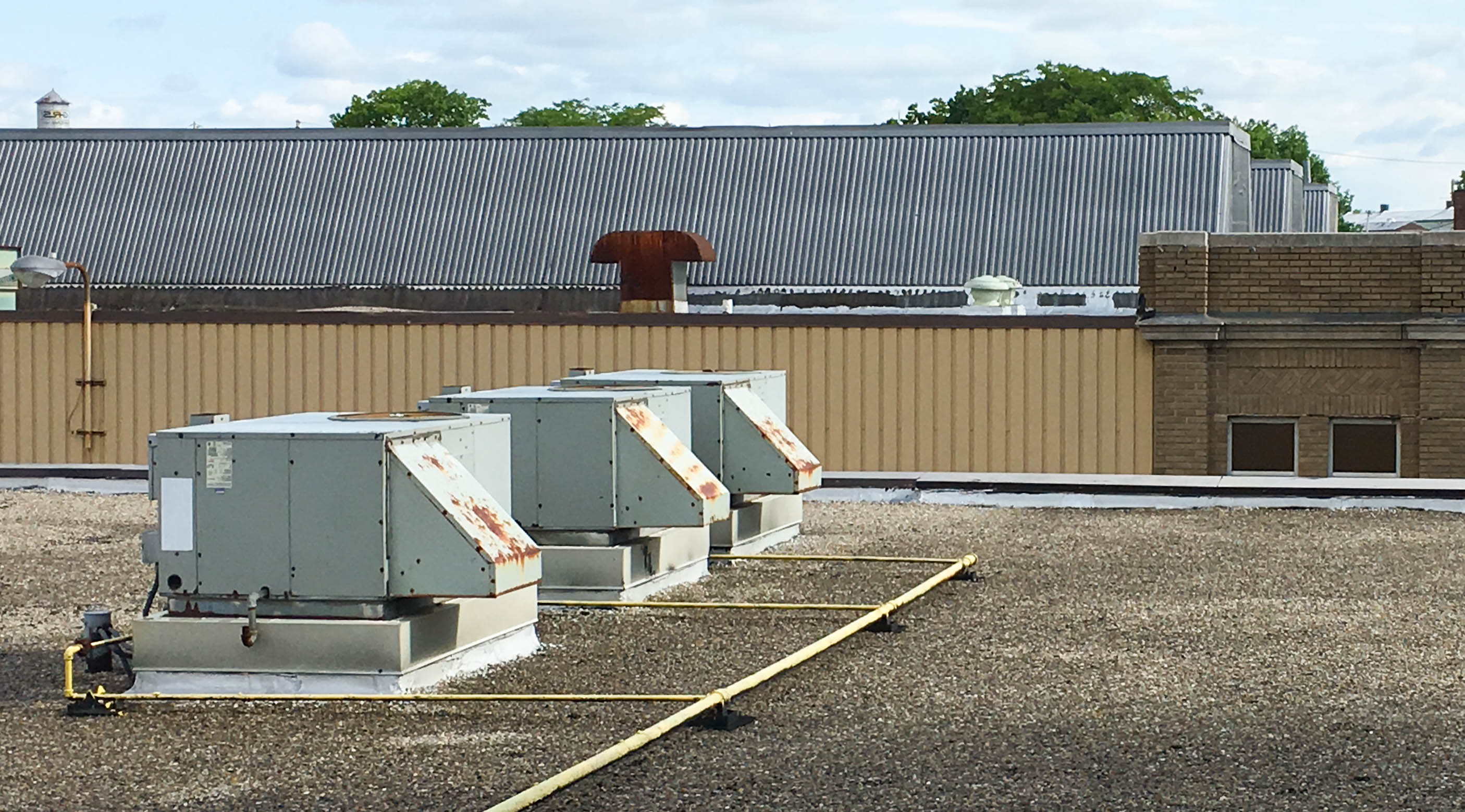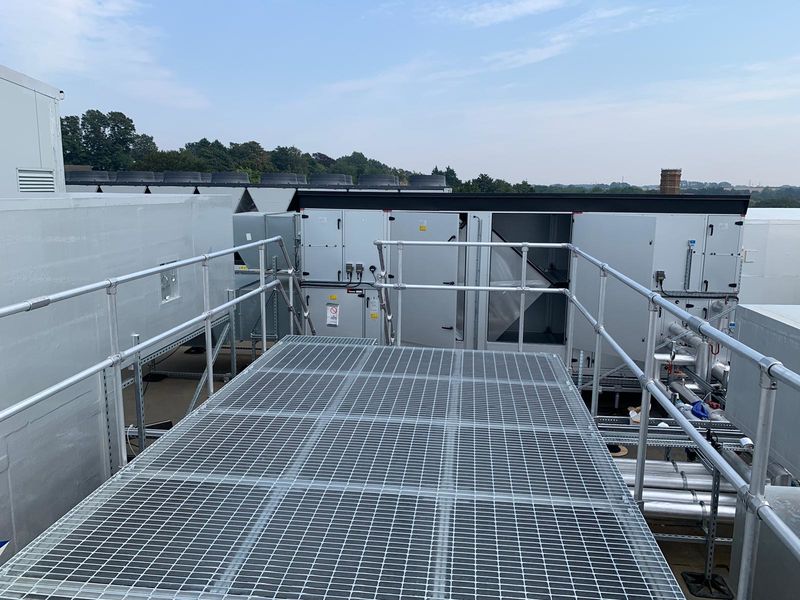Protecting HVAC Technicians With Fall Protection

Does this look familiar?
HVAC units are commonly found close to the edge of your roof. Why we insist on putting them there may make sense to the architect or mechanical installer, however, it poses a serious risk to all who need to maintain it.
You're not comfortable sending your people out there, and those who you contract are requiring fall protection to be in place already.
So what do you do?
It is easy to say, "Well just slap some guardrail up there and you should be fine." While that may be true, several clarifying questions must be addressed:
- How long does the rail need to be?
- What if I don’t have room for a railing?
- How strong does the railing need to be?
To simplify this process, we will walk you through how our safety consultants review an issue like this and give you a concrete way to solve not just the HVAC protection, but how to create a safe rooftop work environment as a whole.
To start, we need to address why fall protection is required in the first place.
What does OSHA say?
Anywhere the level change is 4’ or more, a form of fall protection needs to be in place. If you’d like to dive into the specifics, here is a link to the OSHA code 1910.28(b)(1)(i)(A-C).
Also, if you’re working or walking within 15’ of a fall hazard, fall protection needs to be in place. That can be found in 1910.28(b)(13)(i-iii)(A,B). For an easier guide, download our ebook on understanding the distances at which fall protection is required.
With this knowledge in mind, our safety consultants will narrow down the best safety plan and options based on a few questions. Again, we are focused on safety as a whole, not just the HVAC in question.
1) How far down from the roof’s edge is the next level?
That will be the first item to confirm. What is your actual fall clearance? Knowing your fall distances from the roof surface to any obstructions below is crucial when deciding on a fall protection system.
Reason being that if your fall clearance is too short, a fall arrest system will not be compliant and may not ‘catch’ you in time before hitting the ground. Fall arrest systems are designed to stretch to reduce the impact of the fall. Stretching takes time and requires a further fall.
Keep in mind that the "next level" can be another rooftop, a tree, and potential truck driving into a dock, anything that you could hit from falling in that area.
2) How do you access the roof?
As safety consultants, we need to see the whole picture to ensure the right safety system is recommended. Simply accessing your roof can be far more dangerous than servicing the HVAC unit.
Whether it be a hatch, ladder, or even stairs, it is likely that you will be exposed to a fall hazard during your ascent, descent, and/or traveling to and from the HVAC unit.
If you take a ladder for example, by the time you step off the ladder, you are immediately exposed to a fall hazard. You are well within 15’ of the edge, meaning some form of fall protection needs to be in place.
3) How do you get from the access point to the work area?
Now that your access point is protected, you must now scale the roof to arrive at your desired location. In a perfect world, that would be a straight line avoiding any and all fall hazards by at least 15’. Unfortunately, that is rarely the reality.
If your path to the unit takes you within 15’ of the fall hazard, fall protection will be needed in that area as well. Keep in mind that depending on the fall protection system you choose, it can all be integrated into a single system.
4) How far away from the roof’s edge is the HVAC unit?
Now that you’ve finally made it to the working area, determining how much of that roof edge needs protection can be confusing. Essentially, for any location, you may need to stand, draw a line diagonally to the roof’s edge at least 15’ away.
This will be the bare minimum length of the protection required. It’s not that simple, however. Other factors including how often you need to access this area and for how long determine necessary protection.
This information along with a photo or two will give us a fairly thorough understanding of the rooftop conditions.
5) Is service access for the RTU level with the roof?

Are you level with the HVAC system, or is the system on an elevated platform? Climbing a ladder or erecting a temporary work platform is an additional safety hazard when performing work. The risk of falling increases when improperly stabilizing a ladder, slipping on a ladder rung, or installing and removing a temporary platform quickly.
So, what can you do?
Permanent custom-built elevated work platforms and stairs are designed to help your team safely access your rooftop equipment easily.
So, what are the options?
For that, we need to go back to what OSHA says. OSHA 1910.28(b)(1)(i) gives you three options for fall protection:
- Guardrail
- Safety Nets
- Personal Fall Arrest, Travel Restraint, Positioning Systems
Let's go through each option briefly to get a better understanding of the requirements and where they’d be a good fit.
Guardrail
Guardrail, or safety railing, comes in two forms; mounted railing and non-penetrating railing.
Guardrail is identified as a passive system, meaning it does not require anything of the worker for the system to protect them. This means it is inherently taking human error out of the fall protection, making it a safer solution.
This type of fall protection requires minimal engineering and often is available in pre-engineered product lines.
The downside is that it’s typically visible on your rooftop.
Safety Nets
Safety nets, more commonly found during the construction of new buildings, are now a viable option for a fall arrest system.
Still considered a passive fall protection system, the most significant difference between this and the guardrail is that you can actually fall off the roof.
The netting will need to be attached to the building, requiring a certain amount of engineering. As it will need to catch a person falling, regular inspections of the netting and attachments are required.
Personal Fall Arrest, Travel Restraint, Positioning Systems
Including PPE items such as roof anchor points, full body harnesses, safety lanyards, SRL’s, these types of fall protection are considered an active fall protection system.
Active fall protection requires the worker to take action to be protected. This introduces human error, making it a less safe option over passive systems.
Anytime anchor points are introduced into a fall protection system, OSHA requires a "qualified person" to sign off on the attachment. This would equate to a structural engineer on-site assisting in the project.
Still not sure what system to use?
If you have a situation where an HVAC is dangerously close to the edge of your roof and would like assistance on how to best protect it, give us a call at 1-866-527-2275.
It’s best to know your options so you can make the right decision for the safety and budget of your organization. Compliance doesn’t need to be expensive, and at the end of the day, safety is paramount.



